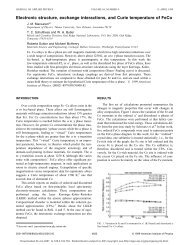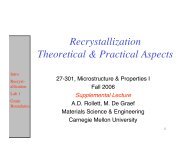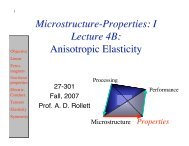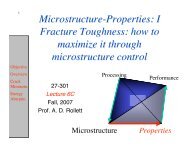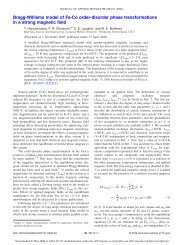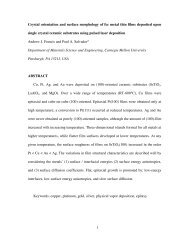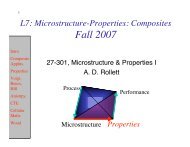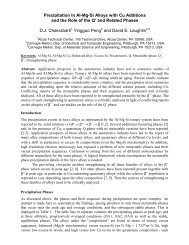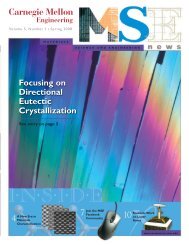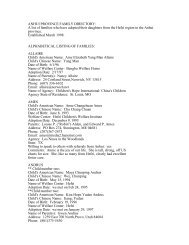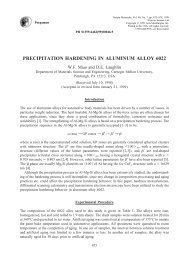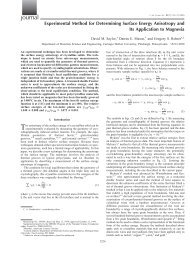popLA Manual (PDF) - Materials Science and Engineering
popLA Manual (PDF) - Materials Science and Engineering
popLA Manual (PDF) - Materials Science and Engineering
Create successful ePaper yourself
Turn your PDF publications into a flip-book with our unique Google optimized e-Paper software.
esponse to some procedure you have asked for; others (such as ROTATE by 90°) do not: you have to edit the<br />
file afterwards.<br />
The simplest system would be XYZ=123=ABN=RTC. This could work, for example, for rolling – if you<br />
mounted your sample correctly on the goniometer, called the rolling plane normal 3, the rolling direction 1,<br />
plotted the RD to the right, <strong>and</strong> used Roe (or Matthies or Kocks) conventions for the Euler angles. It would also<br />
work if you mounted your sample differently, called the rolling direction 2, plotted it upwards, <strong>and</strong> used Bunge<br />
angles. (Kallend uses the Roe convention, but likes the RD up: that's why some <strong>popLA</strong> programs default to<br />
IPER=( 2 1 3).<br />
Clearly, such procedures are not general, <strong>and</strong> no convention exists for tests other than rolling. The general<br />
procedure we use <strong>and</strong> recommend is as follows.<br />
1) The most important step is to mark your sample before you initiate a texture measurement. (If you<br />
should later want to change those marks, you can simply edit IPER in the resulting files.) Unless the sample has<br />
at least orthotropic symmetry, make sure the marks have a sign. (If you have a clockwise goniometer, it would<br />
be best to choose the marks in a left-h<strong>and</strong>ed system so that, after spin inversion, it is right-h<strong>and</strong>ed.) It is best to<br />
enter IPER in the sequence ABN, so that when the RAW <strong>and</strong> EPF pole figures are plotted (RTC=ABN), they<br />
can be related directly to the specimen (perhaps with inverted spin).<br />
2) For the analysis, first decide on what type of OD you want to use; in other words, in which sequence the<br />
numbers should appear in the SOD file (<strong>and</strong> the subsequent COD, etc.). (If you want to use LApp, or a weights<br />
file for any other purpose, you are stuck with Kocks; but for the present discussion, Roe <strong>and</strong> Matthies would be<br />
equivalent.) Then manipulate the EPF until the first row proceeds from a sample azimuth (Ψ or α or ϕ1) of zero<br />
to increasing values. Use this EPF for input to the harmonic <strong>and</strong>/or WIMV analysis programs. If you prefer, for<br />
visualization, a pole figure that is rotated from the so-obtained EPF, make it separately (for example, in<br />
ROTATE, or from within POD). You should now re-edit IPER so that the labels on the OD sections <strong>and</strong>/or the<br />
pole figures relate correctly to the specimen.<br />
3) The above procedure assumed that Z=N=C (but not necessarily =3). If you want to analyze your data<br />
with a Z axis that is convenient (e.g., because it has higher symmetry), but is not easy to measure (Z=C*N), the<br />
best procedure is to first complete the measured EPF, go right through to a WPF in the "wrong" system, then<br />
TILT this by 90° about the horizontal axis (you may have to EXPAND <strong>and</strong>/or ROTATE first), <strong>and</strong> use the<br />
resulting (full) pole figure as input for a second WIMV analysis, now in the preferred coordinate system.<br />
(Again, re-editing IPER is advised.)<br />
APPENDICES 46



